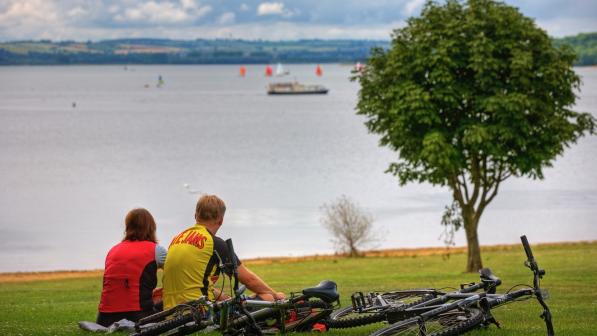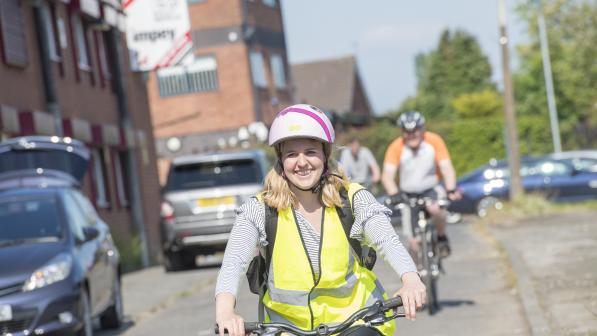Cycling tips: Essential riding advice for beginners
Before you go
Pump your tyres to the right pressure
Possibly the simplest aspect of cycle maintenance is pumping up your tyres the right pressure. What is the right pressure? That’s simple, too – it’s written on the sidewall of your tyres, just take a look.
You’ll notice the tyre manufacture has a recommended range rather than one absolute pressure. That’s so you can adjust the tyre pressures according to the conditions.
If you’re going somewhere that might be damp and slippy, don’t pump your tyres up too hard. If it’s dry and you want to ride as efficiently as possible, fill them up.
Get your saddle height and riding position right
Saddles that are too low make it hard to use your full pedalling range and leg power; saddles that are too high have you straining and can lead to injury. Ideally, you need your saddle height set so there is a very slight kink at your knee when your foot is at the bottom of the pedal stroke.
Then get your position on the bike right, too. A very simple rule of thumb is, when in your typical riding posture you want the handlebar obscuring your view of the front wheel hub.
Cycling isn’t supposed to be painful, so if you find you’re starting to develop backache or any other ailment, pop to your local bike shop to see if they can help adjust your position.
Dress for the conditions
‘There’s no such thing as the wrong weather, just the wrong clothes,’ so the old cycling adage goes, and most of the time, that’s quite true. Weather can change quickly so master the art of layering your clothes so you can take cool down or warm up quickly. What to cycle in when it is cold or in the heat of summer can be a bit trickier.
What to take
Water and food
There’s no worse feeling on a bike than dehydration or complete energy depletion, so take fluid and some ride rations with you. Snacks like a banana, flapjack or jelly babies (for a quick burst of sugar) will help refuel you.
If you are going far, scientifically formulated products such as electrolyte drinks and protein bars can help you avoid cramp or other mid-ride problems, and maximise the benefit of all your efforts.
Padded shorts
New cyclists often think they need huge padded saddles to protect their posterior but that’s really not the case. A good pair of padded cycling shorts will give you enough comfort to survive initial rides, and you can build up time and distance as your tolerance allows. Don’t wear underwear underneath padded shorts, as it may rub and give you saddle sores.
Cycling gloves and mitts
One thing new riders often don’t think about, though, is their hands. These can fatigue quite quickly, so a good pair of padded gloves or mitts will do wonders.
Take a lock and lights (just in case)
Even if you only plan to pop out for an hour or two, if there’s any chance you might be delayed beyond dusk, have a set of lights fitted to your bike.
By the same token, carrying a lock comes in handy for any unplanned corner-shop visits or even café stops. Never believe your bike is safe, even if you leave it unattended for just a moment.
Have a saddlepack with tools, spares and cash
A few choice tools and a spare inner tube in a saddlepack or saddlebag will help you cope with common mid-ride problems. A multi-tool with a range of bits should let you adjust most mechanical components; a chain tool will help you put a broken chain back together; and you’ll need some tyre levers, puncture repair kit/spare inner tube and mini-pump.
We think it’s handy to have some emergency cash and a card, too.
Where to go
Start small and build up the distance you can cycle
For your first cycle ride a great place to build your confidence is a traffic-free trail or park. If you haven’t cycled in a long time aim to cover around five miles and then build up your distance, so that you don’t over do it. Little and often is the best way to increase strength and confidence.
Find some ride buddies
Cycling alone is great – it lets you clear you head, enjoy some solitude and take in the beauty of the world without distractions. But riding with people is good fun too, and having some cycling buddies will help all aspects of your cycling develop much more quickly. Your local cycling group may have rides for beginners or join one of our Community Cycling Clubs.
Map it out
It’s great to head out on the open road or trail and see where the day takes you, but it’s also rewarding to have a ride challenge set out in advance. Online mapping will help you plan out an awesome route for the ride ahead (or find your way back home once you’re lost in the wilds). Our journey planner, routes and cycling area guides should also help.
What to do
Learn to use your gears
Gears are there to make your life easier, but not everybody understands how they work. As you cycle more, start to recognise how changing gears either makes you work harder and go faster, or spin easier but move more slowly. The ultimate goal is to use your gears to keep up a steady rhythm.
Pedal at a steady rhythm
When cycling you neither want to be spinning your legs like crazy nor straining to push the pedals. Ideally, you want a pedalling speed or ‘cadence’ at about 70-90 revolutions per minute.
This will work your cardiovascular, aerobic system – which is more efficient more than your muscular, anaerobic system – and will improve your endurance and all-round health. Work out what 70-90 rpm pedalling feels like then use your gears to maintain it.
Be confident on the road
New riders often think the safest thing is to keep as far to the side of the road as possible near the curb, but this very, very wrong. Other road users might not see you or will try to squeeze past when there’s not enough room. Assume a confident position on the road, ride a good 1m from the kerb, and assert your right to use the carriageway. Our video on road positioning should help.
Learn to corner properly – inside pedal up
As you cycle more, you’ll discover lots about riding technique but here’s one easy tip to get you started: when you take a corner, lift the inside pedal so it’s at the top of your pedal stroke. That way, when you lean into the corner, the pedal won’t hit the ground.
Treat other road users with care
Cycling teaches you a lot about how people (including you) drive. It’s worth appreciating that other road users do make mistakes and remember: even if you think a driver or pedestrian has seen you, don’t take anything for granted.
Don’t hang a helmet from your handlebar
Don’t ride with a helmet hanging from your handlebar. This is incredibly dangerous because the straps can get caught in your front wheel.
Embrace exploration
One of the great things about cycling, especially if you’re using a bike with some multi-terrain ability, is that you can go almost anywhere you fancy. If you see a lane and you’re not sure where it leads, ride down it and find out.
What do when you get back
Clean your bike
Just as cycle maintenance is surprisingly simple, bike cleaning requires nothing much more than a bit of time and some elbow grease (as well as more dedicated lubricants). Read our guide to cleaning your bike.
Lock your bike up
Keep your cycle safe by locking it in a secure location at home. How to stop your bike from being stolen has advice on keeping your cycle safe at home.
Be proud of what you have achieved
Apps such as Strava, MapMyRide, a fitness watch or activity monitor or just your smartphone will help you keep a record of where you’ve cycled and how many miles you’ve racked up, without having to manually log it all in a training book. It can be a great way to encourage you to keep going.
What to learn about cycling
Practise fixing a puncture
Modern puncture-resistant tyres are fantastic but, if you cycle for any length of time, one day you will have a puncture. Practising to change an inner tube in comfort will pay dividends when you find yourself having to do it for real at the side of the road.
(And when you do fix a punctured tyre, don’t forget to look for and remove whatever caused the hole in the first place – otherwise it’ll just pop the replacement inner tube, too!).
Get a bike maintenance book
Most bikes are really very simple bits of technology, so getting to grips with how they work is not as tricky as it might first appear.
Always ask your local bike shop to do any jobs you’re not confident about, but you might be surprised how at much you can fix at home with the right tools and a bike maintenance book. If you want someone to show you how, go on a basic cycle maintenance course.














